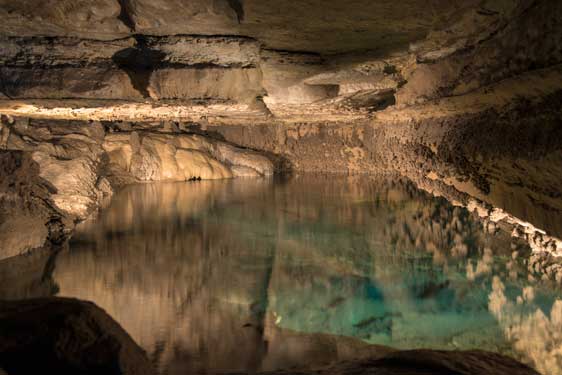Preserving A Portal To Minnesota’s Past In Fillmore County
By Deborah Locke, DNR Information Officer
A 97-foot 1899 bridge in southeast Minnesota got the surprise of its long-life last November when a crane lifted it from its shifting foundation to a nearby fenced-in area provided by Parks and Trails.
“They spent a week preparing to move it, and 15 minutes actually moving it,” said Bob Storlie, park manager at Forestville/Mystery Cave State Park.
The former vehicular bridge crossed the Root River southern branch and once served horse-drawn wagons leading to today’s historic Forestville district. While the bridge is repaired, it will be replaced by a temporary pedestrian fiberglass bridge purchased by the Minnesota Historical Society (MHS). It will be 100 feet upstream from the bridge’s original location. When rehabilitation funding is secured, the original 1899 refurbished bridge will return to its original location to serve more generations of Fillmore County residents and visitors. Vehicle use will be prohibited; other uses haven’t been determined yet.
As with so many state projects, numerous players are involved with the bridge’s future. The state Department of Transportation closed the bridge to vehicle traffic in 2007 due to flood damage; faulty masonry abutments and other deficiencies persuaded Fillmore County officials to completely close the bridge in 2022. If left in place, the bridge would eventually fall into the river, said Kent Skaar, Parks and Trails senior project manager. Or the next flood could take it out, added Garret Owens, a bridge engineer with the state Operations Services Division.
“The three entities, Filmore County, the Historical Society and Parks and Trails, all recognized that the bridge was a structure worth saving,” Garret said. “Rehabbing the bridge on dry land was the best decision.”
The three entities also create a hodgepodge of complexity. Fillmore County owns the bridge and the highway that the bridge is on. State land on the west side of the bridge is managed by the DNR; state land on the east side of the bridge is managed by MHS. For decades the county and agencies have discussed who manages what, who pays for what, and who is responsible for bridge upkeep after its facelift. When the work is completed, the U.S. Secretary of the Interior will review the structure to see if it meets federal standards. The State Historical Preservation Office also gets involved to ensure that the historic character of the bridge is preserved. The bridge leads to the Forestville historic district with buildings listed with the National Register of Historic Places.
Where the bridge leads captures Bob Storlie’s attention. After the rehabilitation is completed, visitors will park on the south side of the river and walk across the bridge that doubles as a portal into the state’s past, he said. Until a few years ago, Forestville visitors might note fast-moving SUVs throughout the area. The pedestrian bridge reintroduces slower movement, more aligned with the late 1890s.
The history buffs reading this story will take an interest in just about anything that’s still standing from 1899. But there are numerous area attractions in this far southeast corner of Minnesota, and many have to do with Historic Forestville and the Forestville/Mystery Cave State Park. Like to fish? Plenty of trout streams scattered in and outside the park offer that opportunity.
Images Courtesy Minnesota DNR


















